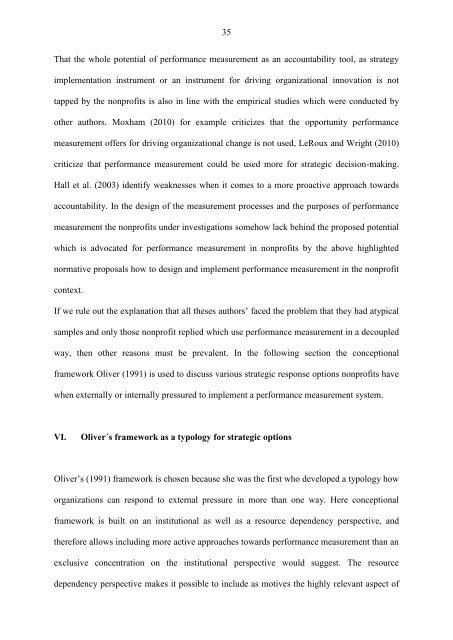Strategic responses to Performance Measurement in Nonprofit ...
Strategic responses to Performance Measurement in Nonprofit ...
Strategic responses to Performance Measurement in Nonprofit ...
You also want an ePaper? Increase the reach of your titles
YUMPU automatically turns print PDFs into web optimized ePapers that Google loves.
35<br />
That the whole potential of performance measurement as an accountability <strong>to</strong>ol, as strategy<br />
implementation <strong>in</strong>strument or an <strong>in</strong>strument for driv<strong>in</strong>g organizational <strong>in</strong>novation is not<br />
tapped by the nonprofits is also <strong>in</strong> l<strong>in</strong>e with the empirical studies which were conducted by<br />
other authors. Moxham (2010) for example criticizes that the opportunity performance<br />
measurement offers for driv<strong>in</strong>g organizational change is not used, LeRoux and Wright (2010)<br />
criticize that performance measurement could be used more for strategic decision-mak<strong>in</strong>g.<br />
Hall et al. (2003) identify weaknesses when it comes <strong>to</strong> a more proactive approach <strong>to</strong>wards<br />
accountability. In the design of the measurement processes and the purposes of performance<br />
measurement the nonprofits under <strong>in</strong>vestigations somehow lack beh<strong>in</strong>d the proposed potential<br />
which is advocated for performance measurement <strong>in</strong> nonprofits by the above highlighted<br />
normative proposals how <strong>to</strong> design and implement performance measurement <strong>in</strong> the nonprofit<br />
context.<br />
If we rule out the explanation that all theses authors‟ faced the problem that they had atypical<br />
samples and only those nonprofit replied which use performance measurement <strong>in</strong> a decoupled<br />
way, then other reasons must be prevalent. In the follow<strong>in</strong>g section the conceptional<br />
framework Oliver (1991) is used <strong>to</strong> discuss various strategic response options nonprofits have<br />
when externally or <strong>in</strong>ternally pressured <strong>to</strong> implement a performance measurement system.<br />
VI. Oliver´s framework as a typology for strategic options<br />
Oliver‟s (1991) framework is chosen because she was the first who developed a typology how<br />
organizations can respond <strong>to</strong> external pressure <strong>in</strong> more than one way. Here conceptional<br />
framework is built on an <strong>in</strong>stitutional as well as a resource dependency perspective, and<br />
therefore allows <strong>in</strong>clud<strong>in</strong>g more active approaches <strong>to</strong>wards performance measurement than an<br />
exclusive concentration on the <strong>in</strong>stitutional perspective would suggest. The resource<br />
dependency perspective makes it possible <strong>to</strong> <strong>in</strong>clude as motives the highly relevant aspect of
















